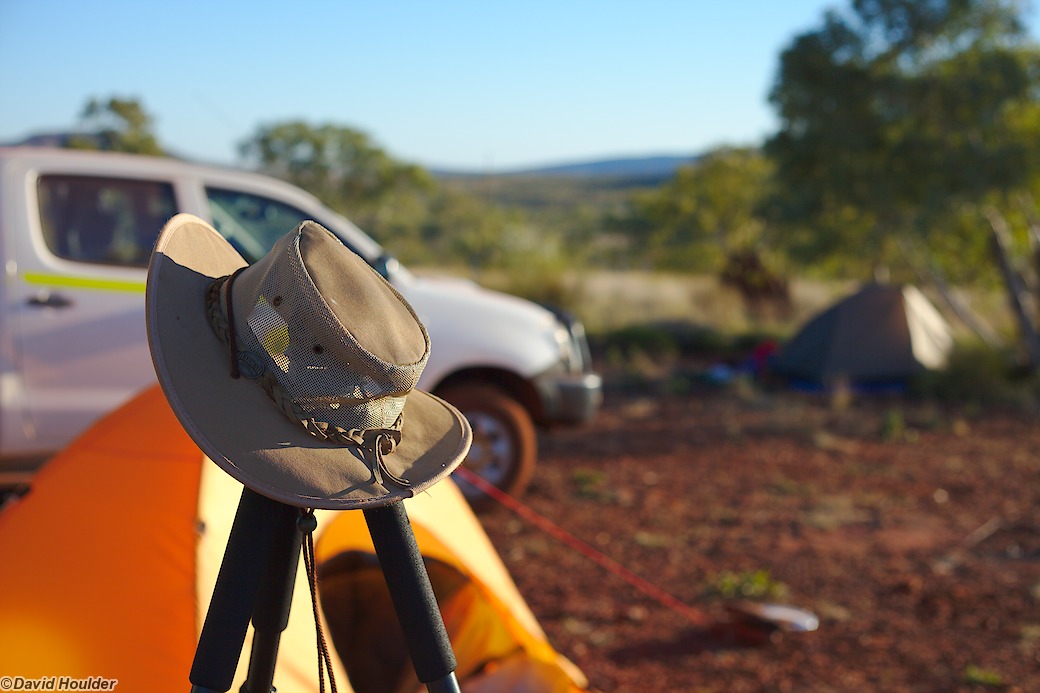Karijini 2
The plan 🔗
In mid 2012 I decided that I'd like to head back to Karijini again for another photography trip. The previous trip in 2011 was fantastic, and I felt like I could spend another couple of weeks there at least.
I sent out a general invitation through PhotoAccess and to cut a long story short, in July 2013, Steven Shaw, Helen and Phil McFadden, Stephen Best and myself arrived in Paraburdoo ready to start two weeks of camping and photography.
The plan was fairly straightforward and worked really well. We flew into Paraburdoo and hired a couple of 4WD dual-cab utes. We spent the first night in the Paraburdoo caravan park, and the next day driving to Tom Price to stock up on groceries, park passes and fuel, and then on to Karijini National Park. Our second night was spent at the Savannah campground, but the remaining nights were spent camped outside the park along a bush track.
That arrangement worked so well that we kept that base camp for the whole two weeks.
And the results? 🔗
After the trip we had a show-and-tell dinner back in Canberra. I was surprised by the diversity of images we got. Despite the fact that we were in danger of tripping over each other in a few places, we all got quite different results. Sure, we all got enough long-exposure running-water images to sink a ship, but there were also some stand-out abstracts and landscapes as well. We all had either full-frame or APS-C DSLRs or MILCs, but Stephen Best also brought along a medium-format pinhole camera, which he ended up using almost exclusively.
I've processed all my images using darktable, an open-source photography workflow application and raw developer. This is the first time I've used it, and I'm very impressed. I think I'll be using it from now on.

Muzzy's Hardware in Tom Price was kind enough to lend us a little table, which made the campsite a bit more civilised. We bought some cheap folding chairs from them too, which we returned with the table, so maybe next time we can borrow those as well.
We hired two dual-cab utes, and despite some mechanical problems (a dead battery in one), and less than stellar performance from both the other vehicle and the rental company, I think they were a good choice. You can fit three people and camera gear in each one, and chuck all the less delicate gear in the tray. With the tailgate down they provide a good surface to cook and sit on too.

You can use the hat to collect donations to fund the purchase of a new tripod that weighs less than the one you already own.



The main attractions in Karijini are undoubtedly the gorges. Oxers Lookout offers a spectacular view into the junction of Red, Hancock and Weano Gorges. We visited this spot on our first afternoon in Karijini, and I think it was a good place to start - might as well start with a bang I reckon.
The figure in the foreground is Steven Shaw, who's perched himself on a rock slab for a better view into the gorge.








The figure in blue on the opposite bank is Steve Best, setting up his pinhole camera.
A pinhole camera is really just a light-tight box with a tiny hole in the front where the lens would normally be. In a normal camera, the lens focuses the incoming light to points on the image sensor or film. A pinhole camera uses a simpler principle - light travels in straight lines, so if you put a tiny hole in the front of the box, the only thing that any point on the film can "see" through that hole is a tiny corresponding point in the outside world. Apply that idea to all possible points on the film plane, and you've got something that can form an image. The images from the camera have a distinct, soft look.


Yes, the rock really is blue in places - sometimes almost sky-blue. It's actually blue asbestos which was mined just a few kilometres from here at Wittenoom, with tragic consequences.




I've got my camera on the tripod and I'm criss-crossing the campsite looking for views of the horizon that aren't obscured by nearby trees.
"What are you doing?" asks Steve.
"I've got an idea" I reply.
And here it is. This is a montage of dawn and dusk skies at the campsite over one 24 hour period. I haven't applied any enhancements or filters during processing - all I've done is set the white balance to "daylight" on them.
